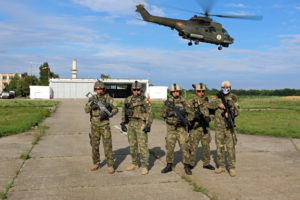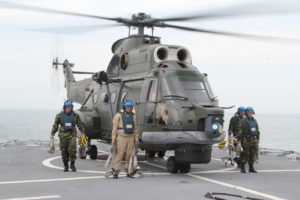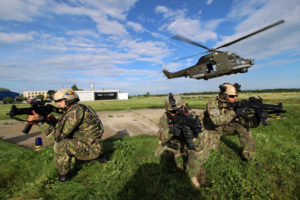
 Romania’s Navy (Fortele Navale Române/ FNR) is small compared to other naval forces in the Black Sea region and within NATO. Although it has a number of frigates, corvettes and minesweepers, the size of the naval aviation component is limited to three IAR.330 ‘Puma Naval’ locally designed and built helicopters, all serving a variety of tasks. The ‘ Black Sea Knights’ helicopter squadron is housed at Tuzla Airport, located southwest of Constanta, and is operating the three IAR.330s.
Romania’s Navy (Fortele Navale Române/ FNR) is small compared to other naval forces in the Black Sea region and within NATO. Although it has a number of frigates, corvettes and minesweepers, the size of the naval aviation component is limited to three IAR.330 ‘Puma Naval’ locally designed and built helicopters, all serving a variety of tasks. The ‘ Black Sea Knights’ helicopter squadron is housed at Tuzla Airport, located southwest of Constanta, and is operating the three IAR.330s.
In 2017, Romanian Naval Aviation will celebrate its tenth anniversary. The history of Romanian Naval Aviation dates back to June 1920 when the first aircraft arrived. By the end of World War 11, twenty-four Heinkel He-114s were in service. These seaplanes were withdrawn from service over the years with no replacement. Naval Aviation operations were disbanded in May 1960 when the last eight He-114s were scrapped.
In the late 1980’s, when the first Tetal II class frigate and destroyer ‘Mărășești’ entered service with the FNR, a number of IAR.316B Alouette helicopters were outfitted with inflatable flotation gear and a winch on the port side, as well as foldable main rotor blades. The two Tetal II class ships have a deck capable of handling one IAR.316B while ‘Marasesti’ has a deck and hangar capable of accommodating two IAR.316Bs. The helicopters were sourced from the Air Force (Fortele Armee Română/ FAR) inventory, based at Tuzla at the time. With the disbandment of the 59th Helicopter Group from Tuzla in 2001 and the retirement of most of the IAR.316s, the Romanian Navy found itself with no helicopter support from the FAR. The few operational IAR.330s from the disbanded squadron at Tuzla transferred to the 863rd Helicopter Squadron at Mihail Kogalniceanu.
“With the acquisition of two Type 22 frigates; F-221 Regele Ferdinand (ex HMS Coventry) and F-222 Regina Maria (ex HMS London) in 2004 it became clear there was a need for a dedicated naval helicopter force and procedures had to be adopted resulting in a steep learning curve for our crews. Without helicopters we are not able to perform all our tasks” explained Captain Ioan. “They are a vital part in our ASW/ASuW tasks”.
“In March 2016 a modernization programme was started to upgrade the Type 22 frigates to carry out ASW and Anti-Surface Ship Warfare (ASuW) missions and to improve the Command & Control systems onboard. The upgrade had a timespan of three years, and should be finalized in 2019,” he added.
A request for three new helicopters was issued. Elbit Systems & IAR Brasov were given contracts in July 2005. They were to cooperate with FHL Claverham, Aerazur, Rockwell Collins, Breeze Eastern and Rafael Company from Israel. The first IAR.330 Puma Naval (#140) made its first flight at Ghimbav, Brasov on 30 January 2007. The IAR.330 Puma Naval underwent testing from February until June 2007, including sea trials and ship compatibility tests.


On 13 July 2007, the ‘Black Sea Knights’ squadron was formally re-established after forty-seven years of absence with the introduction into service of the first IAR.330 Puma Naval (#140) assigned to the Type 22 Frigate “Regele Ferdinand”. By the end of 2007, each of the eight Naval Aviation pilots had logged a total of 25 flight hours. The second IAR.330 Puma Naval (# 141) was delivered during January 2008. After the delivery of the third IAR.330 Puma Naval (‘142’) in 2009, the squadron relocated to Tuzla. “ Initial tasks were mainly day operations, learning to operate the Puma and to get used to seaborne operations,” explained Lt. Cmdr. Bogdan Curca. “The next phase was training and exploring the capabilities of the tactical consoles onboard, lastly, in the period 2009-2010, night operations were high on our agenda in the training syllabus so we could operate 24/7 when required”. Currently not all pilots are qualified for night operations.
The main modifications to the Puma Naval, compared to the standard IAR.330L variant, are: cockpit layout, Rafael Toplite eletro-optical ball senor in the nose (EOP), laser and radar warning receivers, blade antennas under the tail boom and on top of the main rotor fairing, chaff and flare dispensers under the main gear. These modifications can also be found in the IAR.330 SOCAT fleet of the Romanian Air Force (FAR). For naval operations a number of changes were made to the basic IAR.330L airframe: foldable main rotor blades, inflatable flotation gear, door-mounted winch on the starboard side, anti-crash seats, harpoon for deck landing in rough weather conditions, crash position indicator on the port side of the tail boom, two searchlights under the fuselage and a bubble-type observation window on the sliding doors. “We basically added what devices we require for naval operations to the standard IAR.330L airframe,” said squadron commander Marius Mitric.
At the time of the Authors visit, exercises were conducted with the DDG-78 USS Porter to share experiences and procedures operating in a multi-national environment. This also included deck landings of an IAR.330 on the USS Porter. Up until now the FNR have been involved in Unified Protector (2011) and Operation Atalanta (2012) as part of European Union Naval Force (EU NAVFOR). The latter deployment included an IAR.330, 4 pilots and 12 technicians/engineers. “Before we deployed we had Maritime Interdiction training to prepare ourselves for the anti-piracy mission,” said Commander Ciobotaru. He continued: “We mainly conducted ISR missions off the Somali coast, working with multi-national MPAs using digital cameras. On average, two missions a day were flown during the three month deployment.”
Operational crews in the Puma Naval typically consist of a pilot, copilot and a mechanic, who is also operating the winch in case of SAR missions. “For ASuW missions two operators are added to the crew who are responsible for operating the sonar buoys and datalink 11, used to exchange large amounts of data between helicopter and the ASuW operators onboard our Frigates. The tactical consoles can be added rapidly and can deliver a valuable Recognized Maritime Picture (RMP) to our fleet,” explains Black Sea Knight Commander Mitric.
In December 2005, ten selected naval officers started their initial flight training at the Air Force Academy at Boboc on the IAR.316B helicopter type. They qualified as Navy pilots in July 2006, after finishing a 100 hour training syllabus. “At the beginning, the trainers at Boboc were a bit unwilling to train naval aviators with no experience, luckily this changed as we showed our capabilities and dealt successfully with the fast pace of training” said one of the FAR Naval pilots. The new naval aviators continued with an accelerated training on the IAR.330 SOCAT at Bucharest-Otopeni airport for an additional 75 hours, focusing on day operations, basic manoeuvring and emergency procedures,” said Commander Ciobotaru, one of the current elite naval pilots. At the same time, eighteen ground crew technicians were trained at Boboc Air Force Academy. Two of the eight pilots are also instructors on the IAR.330 Puma Naval.
“As we no longer had any relevant experience in naval operations we had to start building our expertise again. In a way we are a self-learning squadron,” said Lt. Cmdr. Bogdan Curca “To build up our expertise in Anti-Submarine Warfare (ASW) operations we have been working closely with ASW operators on our Frigates since 2014. After extensive training, we gained operational ASW capabilities in 2015. At present, we are conducting real life exercises with Turkish Navy (Türk Deniz Kuvvetleri) submarines, testing our procedures, deploying the new TMS2000 sonobuoys with support of two technicians from Thalys”.
To enhance IAR-330 Puma Naval helicopter’s ASW, Iin June 2013, AR Brasov contracted Thales to develop and deliver TMS 2000 sonobuoy processors. The sonobuoys send acoustic data to the processor through a VHF link, received from the VHF receiver and processed by the aircraft in real-time. The TMS 2000 provides detection, tracking, localization and classification of surface and subsurface targets in all environments by processing active and/or passive acoustic data gathered from the sonobuoys. The TMS 2000 provides mono and multi-static processing modes for all active sonobuoys.
The last stage of the modernization was finalized by late 2015 and ran for two years. The helicopters were fitted with torpedo launchers, extending their operability to anti-submarine warfare. The Puma Naval had previously been outfitted in 2012 with two machine guns (7.62 mm and 12.7 mm), for anti-piracy operations (operation Atalanta). “We have not selected and procured the actual torpedoes yet,” explains Mitric. “The Puma Naval is able to carry various torpedoes. We just select what equipment we want to have and put it on the helicopter. That is our way of working and thinking,” he summarizes. A final decision should be made before the end of 2016 as to which torpedo will be selected. It is most likely to be the BAE systems Stingray torpedo.
To further sustain the future of Romanian Naval Aviation, there are plans to acquire a fourth IAR.330 Puma Naval specifically to support the Batalionul 307 Infanterie Marina (307th Marine Battalion), the elite squadron of the Romanian Marines. The Marines are trained in a similar way as the Green Berets and Rangers and are primarily used for on/off -shore and beach-head establishing missions, as well as fighting in Delta regions such as the Danube Delta. Less well known is their cooperation with GNFOS Grupul Naval – Forte pentru Operații Speciale Grupul Scafandri Incursori (Special Operations Naval Group) who also saw action during Operation Atalanta (2012).
To support the future expansion of tasks and sustain the ‘Black Knight’ squadron a new group of young pilots will be trained at the Boboc training school in the near future.